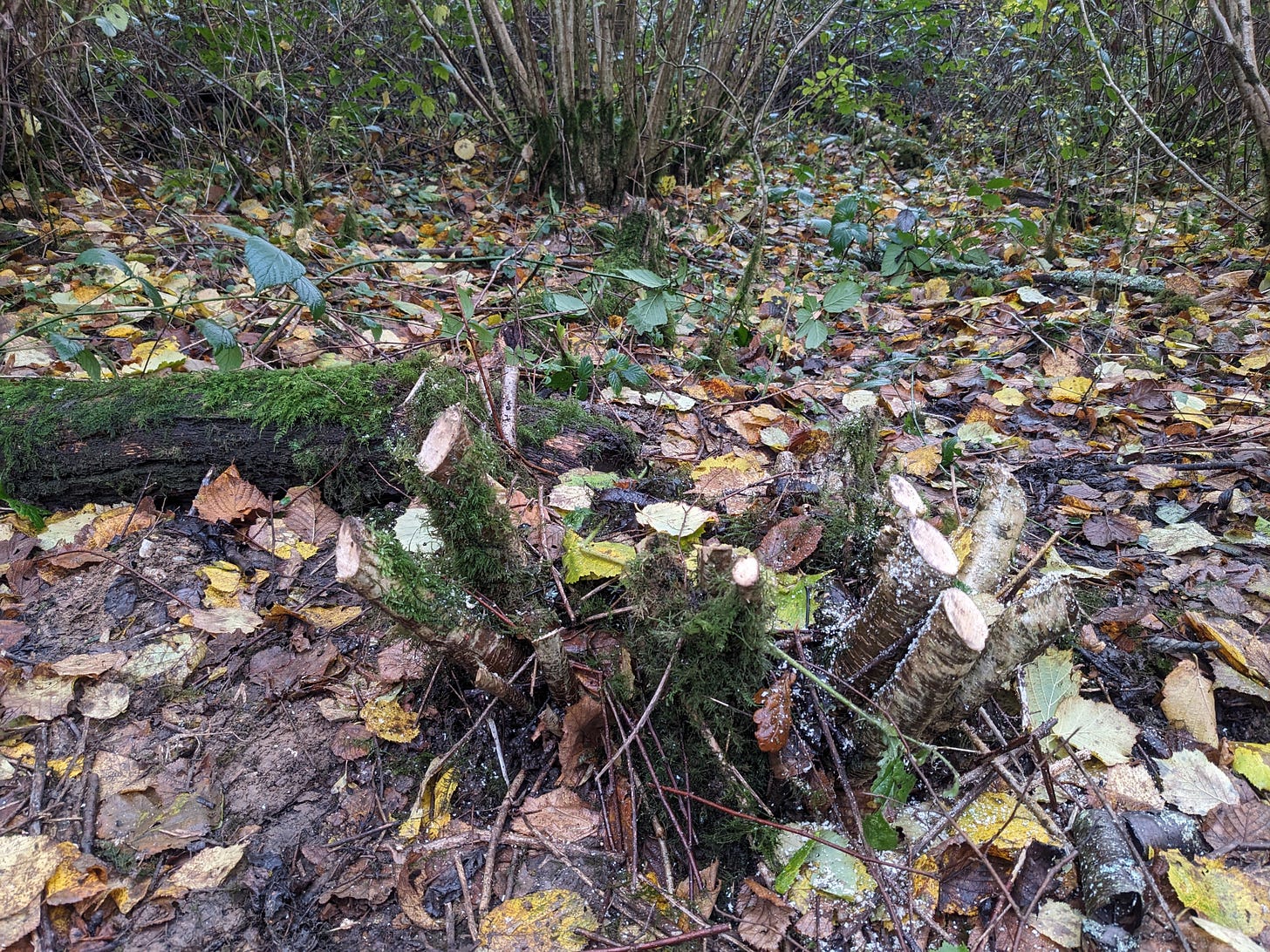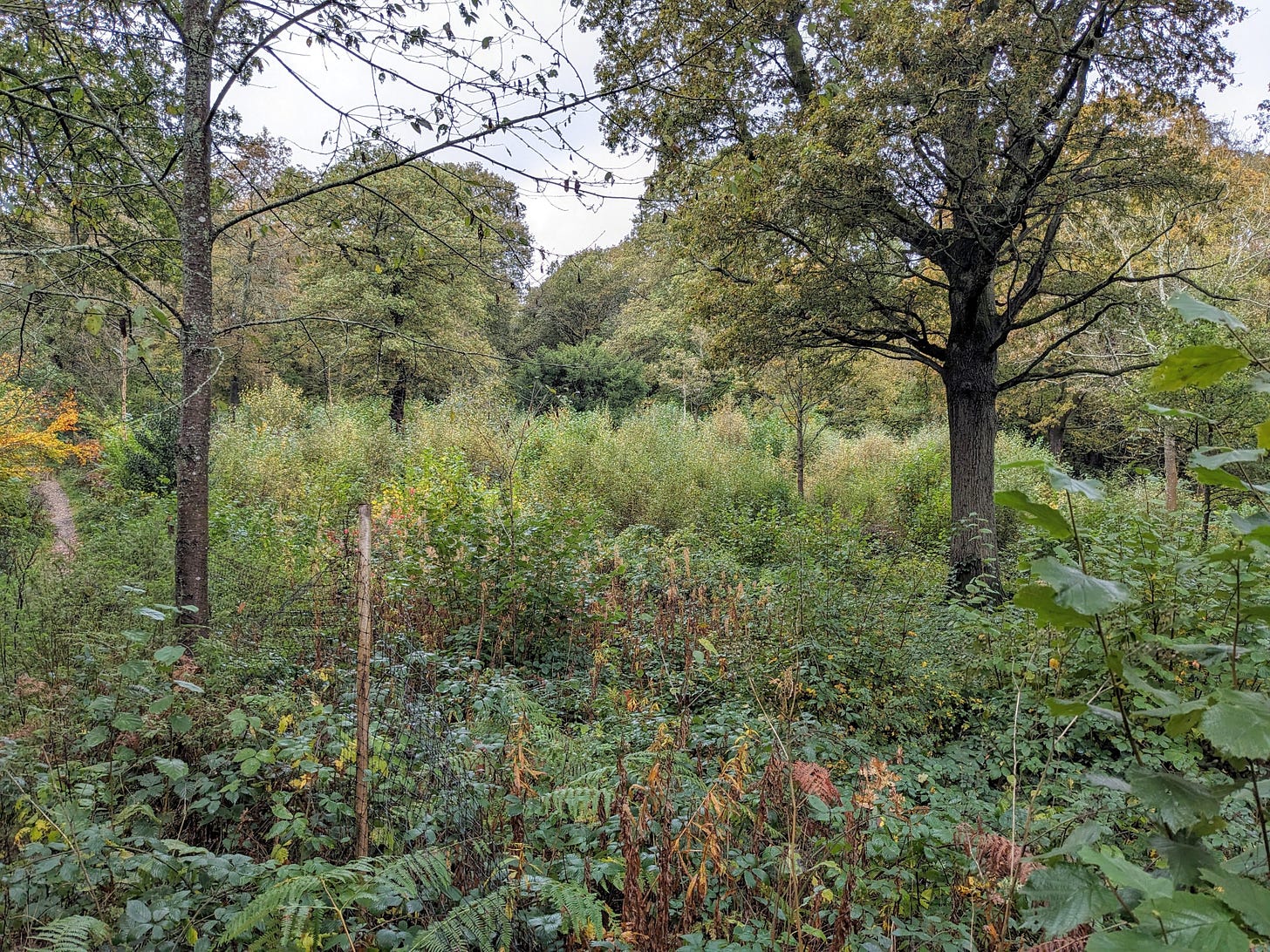Thank you for subscribing to Stories of Coexistence, and welcome to the first newsletter. I’m planning to send these about twice a month to share some of my writing about conservation volunteering and urban wildlife. I’ll finish each newsletter with brief details of a few other things - books, articles, films etc. - usually ones that I’ve enjoyed already and think others would enjoy too, but sometimes I’ll include upcoming events and publications that look interesting.
Let’s get started.
Autumn is a busy time for conservation volunteers. With fledglings long since hatched and the birds flown from their nests, it is safe to begin tree-work again. Our work – pond maintenance, path clearance, felling and occasionally planting trees - varies with the seasons, as such work always has and at this time of year, we spend much of our time coppicing. This involves periodically cutting trees down to nearly ground level after which they will regenerate by sending out new shoots which will themselves be coppiced in later years.
The group I do most of my volunteering with is TCV (The Conservation Volunteers) Croydon. Each year, we return several times over the autumn and winter months to two woodlands right on the edge of London - Devilsden Woods in Happy Valley and King’s Wood in Croydon - and each year we coppice a different section of the hazel trees in these woodlands. Each section – known as a coupe – is cut back every 10-15 years and our last task at the end of each winter is to fence off the coupe that has just been coppiced to create an exclosure, so-called because the objective is to keep the deer out and allow the new growth to flourish. Returning to the same woods year after year provides a chance to see the cycles of regrowth created by coppicing. It is wonderful to see a coupe that was filled with bare stumps at the end of the winter transformed by lush new life when we start coppicing the following autumn.
Both coppicing and pollarding (a similar practice which involves cutting trees above browsing level so regrowth can take place even when there are grazing animals around) are long-established practices. They are activities that our ancestors undertook for generation after generation until only a century or two ago, and it is while we are working in the woods each winter that I feel closest to those who have looked after this land before us. The activities we undertake are not so different from those described in Thomas Hardy’s novel The Woodlanders, and I often like to think of as modern woodlanders. The big difference, of course, is that none of us rely on these woods for our livelihoods anymore, although we do still try to make as much use as we can of the trees we chop down and straight trunks of a suitable length and thickness are kept for use as fence stakes, bean poles or binders for hedge-laying.
In the past when people depended on trees for shelter, warmth, fodder and more, coppicing and pollarding allowed them to take what they needed from the woods and for those same woods to keep on providing for them long into the future. Then we found other materials from which to build our homes and heat them, other ways to feed our animals and other uses for the land. But in the meantime, many wildflowers, butterflies and other species had evolved to take advantage of the cycles of cutting and regrowth. These species have suffered since people abandoned the woods, and now many struggle to find the kind of habitats they need in woodland that’s left unmanaged.
Most coppicing today is undertaken primarily for the wildlife benefits. One of the main aims of our coppicing in Devilsden Woods is to create suitable habitat for the rare hazel dormice that live here. I’ve never been lucky enough to see a dormouse – they’re nocturnal and hibernate during the winter – but I have seen the Silver-washed Fritillary butterflies that have returned to Happy Valley since coppicing was restarted here a couple of decades ago. And at both Kings Wood and Devilsden Woods there are often particularly spectacular springtime displays of bluebells in areas that we have cut the previous winter. Yet another advantage is that trees that have been coppiced usually live far longer than they would have done otherwise.
Given the multiple benefits, it is no wonder that coppicing has been practiced around the world for centuries. Our ancestors understood only too well the importance of taking good care of the natural world around them as it was all they had access to. They understood too how their behaviour affected other species because this knowledge was essential for their survival. Our reliance on the natural world, and the impact we have on it, may be much less obvious to many of us now but we should not forget that the choices we make about how to care for it are as essential as they ever were.
To finish…
…a few things I’d like to share (all books this time!):
1. The Woodlanders by Thomas Hardy: In common with most Hardy novels, there’s a tragic love story at the heart of this book but there is also some beautiful nature writing and Hardy weaves evocative descriptions of the woods and the changing seasons throughout. Here’s just one example: Summer was ending: in the daytime singing insects hung in every sunbeam: vegetation was heavy nightly with globes of dew; and after showers creeping damps and twilight chills came up from the hollows.
2. On Gallows Down: Place, Protest and Belonging by Nicola Chester: This book is an urgent, and timely reminder, that the landscape does not only belong to those who own the land. Chester’s passion for the area in which she has lived all her life is informed by a deep knowledge of the other species which live alongside her. She is determined to pass on that knowledge to her children, not to tie them to this particular landscape, but so “that, wherever they ended up, the nature of the place they found themselves in would be a talisman for them; a lodestone, a waymarker, a way in and a way to ‘home’.”
3. Wildwood: A Journey Through Trees by Roger Deakin: In Deakin’s own words “Wildwood is a quest for the residual magic of trees and wood that still touches most of us not far beneath the surface of our daily lives”. He writes about a wide range of different places and people with a strong connection to trees but some of my favourite parts of the book are when he describes his own experiences looking after the woodland around his home in Suffolk, and the satisfaction he gained from working with trees and developing the skills to do this in a sustainable way.






